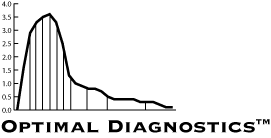
|
Cerebly, Inc. 4951 Brummel Street Skokie, IL 60077-2879 1-724-538-4500 www.optimaldiagnostics.com 
|
|
Optimal Scheduling of Follow-Up and Diagnostic Tests Cerebly, Inc. develops and licenses patented and patent-pending technology for optimizing the scheduling of follow-up and diagnostic tests. The Optimal DiagnosticsTM technology generates surveillance schedules that minimize the expected delay until detection of an event recurrence based on recurrence incidence rate statistics. The technology has applications to medical surveillance, patient monitoring, preventative maintenance, quality assurance, employee monitoring and other business processes. The Optimal DiagnosticsTM technology was mentioned in a September 18, 2007 Wall Street Journal article about the Gotham Prize for Cancer Research. The Optimal DiagnosticsTM technology has been empirically demonstrated to be effective on a series of 910 hepatocellular carcinoma patients. See F. Edward Boas, MD, PhD, Bao Do, MD, John D. Louie, MD, Nishita Kothary, MD, Gloria L. Hwang, MD, William T. Kuo, MD, David M. Hovsepian, MD, Mark Kantrowitz, MS, Daniel Y. Sze, MD, PhD, Optimal Imaging Surveillance Schedules after Liver-Directed Therapy for Hepatocellular Carcinoma, Journal of Vascular and Interventional Radiology, November 4, 2014. Medical Applications A key application area involves using relapse rate statistics to generate medical surveillance schedules for post-treatment follow-up and diagnostic tests. The technology can customize the surveillance schedule given relapse rate statistics that are disaggregated by patient, disease or therapy characteristics, such as staging, histology, treatment protocols, patient age, family history and other demographic risk factors. For most patients this yields equally effective but less expensive follow-up schedules by avoiding unnecessary tests. On the other hand, the customization of the surveillance schedules to individual risk factors necessitates closer monitoring of higher-risk patients. In both cases the technology reduces the cost of salvage therapy by letting it occur sooner when it is more likely to be effective and less toxic. Reducing the overall costs of follow-up also enables the use of follow-up in more situations where it was previously too costly for widespread use. In addition to generating optimal surveillance schedules that are customized to risk factors, the technology also offers other benefits:
This technology can be used to reduce the cost of health care while simultaneously improving the quality of patient care if the following prerequisites are met:
The Optimal DiagnosticsTM technology is of interest to health insurance and pharmaceutical firms because of the potential cost savings from fine-tuning the scheduling of follow-up diagnostic tests. For example, consider the possible savings from eliminating one unnecessary follow-up imaging study per cancer patient. Or the savings from optimizing the scheduling of tests for elevated liver function enzymes in people taking cholesterol-lowering medication, or anticoagulation levels in people taking blood-thinning medications like coumadin. The technology is also of interest to medical practitioners because of the potential for improved quality of patient care. (The technology may also be of interest to medical malpractice attorneys when medical practitioners fail to adjust the surveillance schedules according to patient risk factors.) The technology provides a principled method for determining surveillance schedules in a manner that both saves money and improves the quality of patient care.
Example: Testicular Cancer The most common post-chemotherapy surveillance schedule for testicular cancer (seminoma) involves tumor markers, CT scans and clinical exams every 2 months during the first year, every 4 months during the second year and every 6 months during the third through fifth years, yielding 15 appointments during the first five years (months 2, 4, 6, 8, 10, 12, 16, 20, 24, 30, 36, 42, 48, 54 and 60). This surveillance schedule has an expected delay until detection of a relapse of 3.6 months (110 days), based on a set of typical relapse rate statistics. A surveillance schedule with appointments in months 2, 4, 6, 8, 10, 12, 14, 17, 20, 23, 26, 31, 38 and 51 has a similar expected delay until detection of a relapse (3.4 months or 105 days) but only involves 14 appointments in the first five years. This schedule is slightly more effective, but saves money by reducing the number of appointments. Alternately, if one wanted to keep the number of appointments unchanged but decrease the expected delay until detection of a relapse, one could use a schedule with appointments in months 2, 4, 6, 8, 10, 12, 14, 16, 19, 22, 25, 29, 35, 45 and 60. This schedule has the same number of appointments (15), but an expected delay until detection of a relapse of only 2.4 months (72 days). The earlier detection saves money by improving survival and reducing the toxicity of salvage therapy. Surveillance Schedule Generator Demo A sample implementation of the surveillance schedule generator allows one to generate a waterfall of sample surveillance schedules for a range of thresholds on cumulative risk of a recurrence for a specified set of recurrence rate statistics. This implementation is similar to the source code disclosed in the patent. Disclaimer The information contained on this web site is for informational purposes only and does not render medical or professional advice. The information on this web site should not be used for diagnosing or treating any medical condition. You are strongly advised to seek professional care from a licensed health care provider. Do not disregard professional medical advice or delay seeking professional medical advice because of anything you may have read on this web site. No warranty is made about the accuracy of the information provided on this web site.
Copyright © 2009-2021 by Cerebly, Inc. All rights reserved. U.S. Patent No. 7,523,043 and U.S. Patent No. 7,778,847. Additional patents pending. | |